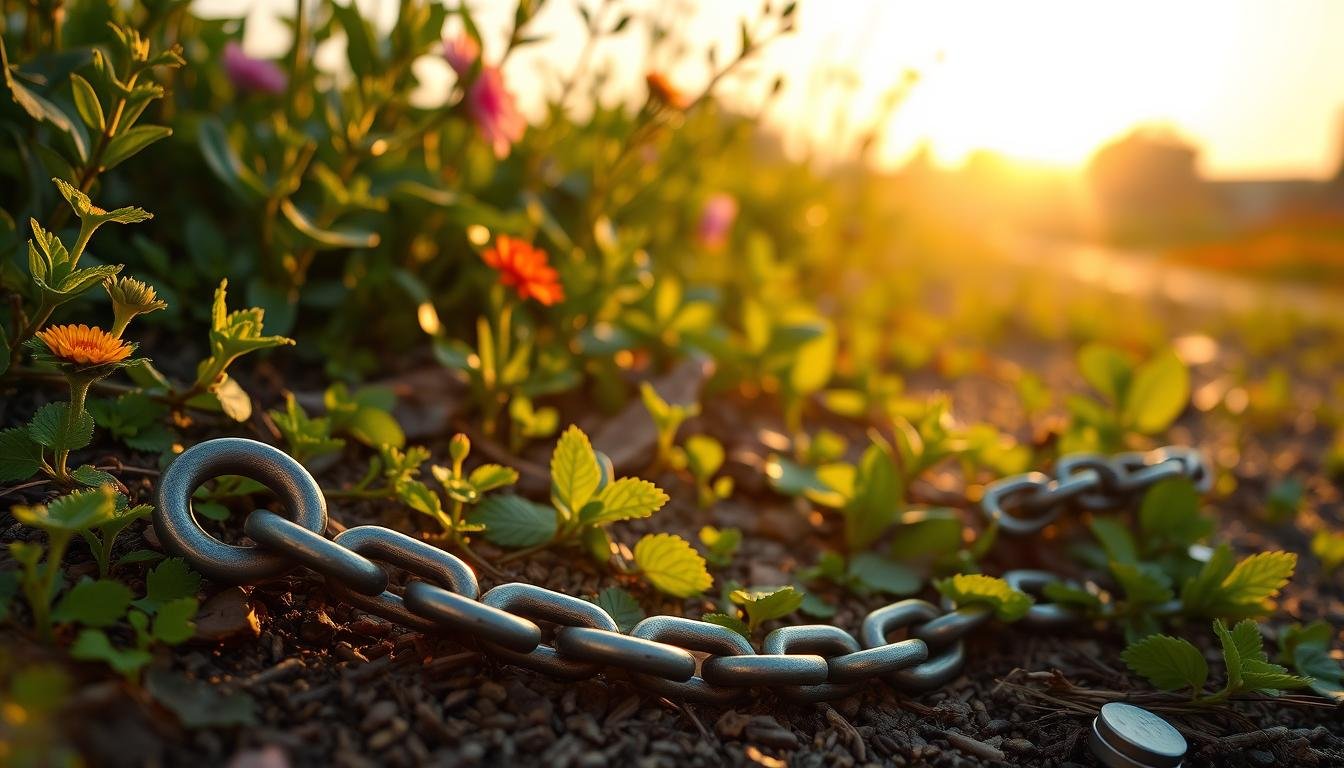Breaking the Cycle of Bad Habits: A Fresh Start
Breaking free from bad habits is tough, but doable. You can overcome unhealthy habits like smoking, overeating, or procrastination. With the right strategies and determination, you can change your life for the better.
Studies show that up to 70% of smokers want to quit. This shows how hard it is to break bad habits. But, practicing self-control can help you succeed.
Starting this journey, remember it’s personal. What works for one might not work for another. By understanding your habits and trying different techniques, you can find what works for you.
Understanding the Power of Habits
Habits shape our daily lives, influencing our behaviors and routines. They can be good, like regular exercise, or bad, like overeating. Understanding how habits form and stick is key.
Why Habits are So Hard to Break
Habits are tough to break because of our brain’s reward system. When we do something habitual, our brain gets a dopamine boost. This makes the habit feel rewarding. But, breaking the cycle is hard because our brain still wants that reward.
The Role of Dopamine in Habit Formation
Dopamine is key in forming habits. It makes us feel good when we do certain things. As we keep doing these actions, our brain starts to look forward to the dopamine. This makes the actions feel automatic, a sign of a habit.
“The secret of your future is hidden in your daily routine.” – Mike Murdock
Habits greatly affect our lives. By learning about habit formation and dopamine, we can change for the better. We can break bad habits and start new, positive ones.
Identifying Your Habit Cues
To break free from bad habits, first understand the triggers that start them. These triggers, or habit cues, can be simple things like where you are, how you feel, or when it is. Knowing what sets off your bad habits helps you change them for the better.
Studies show that replacing bad habits with good ones works better than just stopping the bad ones. This shows why finding and fixing the triggers is key. It lets you tackle the problem at its source, not just its symptoms.
Some common habit cues include:
- Time of day (e.g., reaching for a snack at 3 p.m.)
- Location (e.g., stopping for fast food on the way home from work)
- Emotions (e.g., stress-eating when feeling anxious)
- Social situations (e.g., drinking alcohol at social gatherings)
- Preceding actions (e.g., checking social media after waking up)
By watching and learning about your habit cues, you can start to change. You can make room for better, healthier habits to grow.
“Simplifying new behaviors helps integrate them into autopilot routines more effectively.”
Disrupting Automatic Behaviors
To break bad habits, you need to stop automatic behaviors. This is the hard part. You must interrupt the habit loop and make new paths in your brain. Removing triggers, adding friction, and welcoming discomfort help in habit disruption.
Techniques for Habit Disruption
Removing triggers is a strong strategy. For example, keep your phone away during work. This makes you pause and think before acting.
Creating friction in the habit loop is another way. Make the desired behavior harder to do. Store healthy snacks in hard-to-reach places to curb snacking.
Lastly, accept the discomfort of breaking routine. Psychologist William James said practicing self-discipline builds willpower. This is key for discomfort tolerance and habit disruption.
“The great use of life is to spend it for something that will outlast it.” – William James
Using these techniques daily can help you break bad habits. It opens the door to lasting, positive changes.
Replacing Bad Habits with Good Ones
Breaking bad habits is tough, but replacing them with good ones works better. By swapping an unhealthy habit for a healthy one, you disrupt your brain’s old ways. This makes it harder to go back to the bad habit.
Finding Healthy Alternatives
Finding good habits to replace bad ones is crucial. Here are some examples of healthy behaviors:
- Exercise, such as taking a brisk walk or engaging in a favorite physical activity
- Mindfulness practices, like meditation or deep breathing exercises
- Creative activities, such as drawing, writing, or playing a musical instrument
- Socializing with friends or family members
- Pursuing a new hobby or learning a new skill
By choosing a healthy habit, you meet the needs that led to the bad one. This way, you build a better, more positive life.
Changing habits takes time and effort. Be kind to yourself and celebrate small victories. Focus on making progress, not being perfect. This helps you break bad habits and adopt healthier ones.

Starting your habit-changing journey? Use the tips from this article to help you. Focus on self-care and growth. This way, you can reach your full potential and live a life that reflects your values and goals.
breaking the cycle of bad habits
Changing deep-rooted habits is tough. It needs persistence and resilience. These habits are hardwired in our brains. It takes time, effort, and the courage to face setbacks.
The journey to change habits is not always straight. Relapse prevention is key to lasting success.
Studies show that healthy habits like exercise and balanced diet lead to longer, healthier lives. On the other hand, unhealthy habits like smoking and excessive drinking can lead to health problems.
Starting positive habits early can greatly improve our health and happiness. But, changing habits is hard. It’s important to understand and deal with the reasons and feelings behind bad habits.
“Until you make the unconscious conscious, it will direct your life and you will call it fate.” – Carl Jung
Aristotle said, “We are what we repeatedly do. Excellence, then, is not an act, but a habit.” This shows the power of persistence and the importance of the journey, even with setbacks.
Replacing bad habits with better ones is a good strategy. Find a positive substitute for the bad habit. This helps change our brain’s pathways and build new, good habits.
Remember, changing a habit takes time and effort. Setbacks and relapses are part of the journey. The key is to be kind to yourself and keep going.
Stay focused on your goals and celebrate small victories. This way, you can break the cycle of bad habits and live a healthier, more resilient life.
The Role of Self-Control and Willpower
Breaking bad habits and starting new, better ones needs understanding self-control and willpower. Studies show willpower is like a muscle that gets stronger with practice. Using these skills helps you fight the urge to fall back into old habits and move towards positive change.
Making choices that go against quick rewards is key to changing habits. Self-control lets you ignore quick temptations and keep your eyes on the future. This is hard when old, unhealthy habits call your name.
Building willpower is essential to break bad habits. Mindfulness and making smart choices help build mental strength. This strength is needed to face the hurdles of changing habits.
“Willpower is a learnable skill, not a magical trait possessed by a few. With the right strategies and consistent practice, anyone can strengthen their willpower and achieve their goals.”
Knowing how habits form and the role of self-control helps you change your ways. Changing habits is not easy, but with effort and a desire to grow, you can tap into the power of self-control and willpower.
Strategies for Building Self-Control and Willpower
- Practice mindfulness: Regular meditation or breathing exercises increase self-awareness and help make better choices.
- Break tasks into smaller, manageable steps: Tackling habits one small step at a time saves your decision-making energy and avoids feeling too much.
- Eliminate distractions: Cut out things like social media or too much TV that use up your willpower.
- Celebrate small wins: Reward yourself for any small success in changing your habits to stay motivated and keep moving forward.
Using these strategies daily can help you build the self-control and willpower to break bad habits. This way, you can live a more fulfilling and healthy life.
Visualizing Success
Breaking free from bad habits is tough. But, visualization and mental rehearsal can help a lot. By imagining yourself doing the right thing, you make it easier to do it for real.
Research shows our brains act the same whether we’re doing something or just thinking about it. This mental rehearsal makes new habits stick. It gives you a clear idea of what success looks like.
Visualizing yourself doing well boosts your motivation and confidence. It helps you stay committed to changing for the better.
To use visualization, take a few minutes each day to imagine your new habits. Picture yourself doing it all, from start to finish. Focus on the good feelings and sensations you’ll have. The clearer your mental picture, the more likely you are to make it happen.
Changing bad habits takes time and effort. But with visualization and mental rehearsal, you’re on the right path. You’ll be closer to the life you dream of.
“Visualization is the most powerful mind tool we have to achieve our dreams and all that we want in life.”
– Shakti Gawain
Building a Support System
Changing bad habits to good ones is tough. But, you don’t have to face it alone. A strong support system can greatly help you reach your goals. Social support, accountability, and feeling part of a community give you the push you need to succeed.
Think about getting help from friends, family, or joining a group or online forum for habit change. These people can offer social support, keep you on track, and celebrate your achievements. Being around others who get what you’re going through can really help.
Make sure to stay in touch with your support group. This could be a weekly call or a monthly check-in. These meetings help you stay motivated, find and solve problems, and adjust your plan as needed. Remember, change isn’t always easy, but with a supportive community, you can overcome any obstacle.
“The strength of the wolf is in the pack, and the strength of the pack is in the wolf.” – Rudyard Kipling
Building a support system means you get help and encouragement from others. It also makes you more accountable, which is key in changing habits. Let the power of community be your guide in breaking bad habits and making positive changes.

Celebrating Small Wins
The journey to change habits can be tough, but celebrating small victories is key. Studies show that people who acknowledge their progress are 46% more likely to break bad habits than those who don’t.
Every small step forward, like avoiding unhealthy snacks or taking a daily walk, is worth celebrating. These small wins give you the motivation and positive feedback you need.
- Identify your habit change milestones, no matter how small, and congratulate yourself on reaching them.
- Share your successes with supportive friends and family to amplify the positive reinforcement.
- Use a habit tracker or journal to visually see your progress over time, which can be incredibly rewarding.
- Treat yourself to something special, like a new book, a relaxing bath, or a healthy meal, when you reach an important milestone.
Celebrating small wins keeps you motivated and helps your brain associate positive behaviors with success. This makes it easier to keep up your new habits and reach your goals.
| Habit Change Metric | Progress Milestone | Celebration Idea |
|---|---|---|
| Reducing sugar intake | Cutting back by 10% per week | Enjoy a fresh fruit smoothie |
| Exercising regularly | Completing 3 workouts per week | Get a new workout outfit |
| Reducing screen time | Limiting daily use by 30 minutes | Plan a tech-free outdoor activity |
Remember, changing habits is a journey, not a destination. Celebrating small wins keeps you motivated and on the path to lasting personal growth and transformation.
“Celebrate every win, no matter how small. They all add up to big progress.” – Unknown
Habit Formation and the Brain
Learning about habit formation is key to breaking bad habits and starting new, good ones. Neuroscience shows how our brain works to create habits. This knowledge helps us change our habits for the better.
Neuroscience of Habit Change
The brain’s basal ganglia is where habits start. It helps us do things automatically. As we repeat behaviors, our brain gets better at it, needing less effort.
Dopamine is important in making habits. It’s released when we get a reward, making us want to do it again. Over time, dopamine goes to the action itself, making it hard to stop.
Big changes in life, like having a child or going on vacation, can help break habits. These times change our routines, giving us a chance to start anew.
| Key Insights | Supporting Evidence |
|---|---|
| Habit formation is driven by the brain’s basal ganglia and reinforced by dopamine release. | Studies on rats trained to run a maze for rewards showed that with repetition, their behaviors became habitual, requiring fewer neurons to achieve the same goal. |
| Dopamine triggers the brain’s reward system, making it challenging to break habits. | Researchers observed that as habits form, the dopamine release shifts from the reward to the cue or action that previously led to the reward. |
| Significant life events can provide opportunities to break harmful habits. | Studies indicate that transitional periods, such as having a child or going on vacation, disrupt established routines and offer a window for behavior change. |
Knowing how habits form helps us find better ways to change them. We can then build new habits that match our goals and values.
Mindfulness and Habit Awareness
Mindfulness can help you break bad habits. It makes you more aware of your actions and thoughts. This way, you can notice your habits and choose better ones.
Most habits become automatic after doing them many times. They follow a pattern of trigger, behavior, and reward. Knowing this can help you spot and change unwanted habits.
Mindfulness, like meditation, increases your awareness. It helps you become more intentional and less automatic. Being curious about your habits can also help you see them in a new light.
Knowing what triggers your habits is key to changing them. Mindfulness helps you see these triggers. This way, you can make better choices instead of falling back into old patterns.
“The key to breaking old habits and forming new ones lies in building a strong foundation for willpower by being mindful of basic needs, such as regular calorie intake.”
Adding mindfulness to your daily life can help you control your habits. Remember, changing habits takes time and effort. But with patience and practice, you can build better habits.
Overcoming Setbacks and Relapses
Starting a habit change journey is not always easy. Setbacks and relapses happen, but it’s important to be kind to yourself. Remember, changing habits is a skill that takes time and effort.
When you face setbacks, see them as chances to learn and grow. Think about what led to the relapse. Look at emotional or psychological factors that might have played a part. This self-awareness helps you find ways to handle similar situations better next time.
Being resilient is crucial in overcoming obstacles. Be flexible with your goals and celebrate every small success. Having a support system, like friends or online communities, keeps you motivated. Focus on changing habits, preventing relapses, and building resilience to break bad habits and achieve lasting change.







